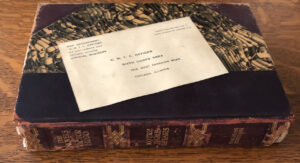
Photo by John Griswold
A yellowed postcard was found recently on page four of an old edition of Victor Hugo’s Notre Dame de Paris, the top of which begins, as a continuation of the previous page, “Fools. On that day there was to be an exhibition of fireworks in the Place de Grève, a May-tree planted at the chapel of Braque, and a mystery performed at the Palace of Justice.”
The book is Volume Six of the Valjean Edition of Hugo’s novels, published by PF Collier & Son, New York. It is undated but probably from 1900 or after. It has a marbled-paper-and-leather hardcover binding with gold lettering and leather spine. The spine is chipped but the pages unfoxed. It is worth maybe 10 bucks.
A desperate reminder on the first page, in my mother’s hand, says, “from the Library of / Senator & Mrs. Wm. J. Sneed, / 501 South Park Avenue, / Herrin, Illinois. 1965.” These were her parents, whose estate was divided, after they died, among four siblings. My mother hated that the library, whatever that meant, was broken up.
The postcard inside was never filled out or used, as if it was only a convenient bookmark. It is pre-addressed to “CMTC Officer, Sixth Corps, 1819 West Pershing Road, Chicago, Illinois.”
The flip side has a pre-printed message: “I am 17 years old. I would like to attend the Citizens’ Military Training Camp this summer. Please send me a folder showing dates and locations of CMT Camps, and an application blank.”
There is a space for the interested’s name and address, then, “Note: Mail this card. It requires no postage stamp. These CMT Camps are conducted by the United States Government.”
CMTC training ran in the summers of 1921-1940. The program was a compromise between a peacetime draft and unpreparedness for war, and it ended when FDR signed the Selective Training and Service Act in September 1940, instituting conscription. Some 400,000 men attended at least one of the month-long CMTC sessions, including Presidents Truman and Reagan, Chuck Yeager, and Robert Penn Warren. It took four training cycles to become a Reserve officer, and only 5,000 were commissioned in 20 years.
Sixth Corps was the Army’s administrative area of Illinois, Michigan, Wisconsin, and (depending on the year) Jefferson Barracks near St. Louis.
My Grandfather Sneed, who undoubtedly bought the Valjean Edition, did not serve in the military. In 1921, when the CMTC started, he was 38 years old. In 1940 he was 57. My Uncle Carl Sneed, his son, was a Naval officer in the Pacific in WWII with combat amphibious forces. I cannot know if he attended a CMTC camp, or if anyone ever read the Hunchback past page four.
This object and the text in which it was found have improbably outlived everyone previously involved—Victor Hugo, his unnamed translator, publisher Peter Fenelon Collier, his son, my grandparents, my uncle, my mother, as well as (almost certainly) anyone who served in the CMTC or trained in its 50 camps around the country, and most who could ever have lived to the time in Herrin, or Chicago, or anywhere.
Yet here they are, a little performance on opening day of its latest revival. Hugo: “‘The mystery! the mystery!’ they murmured, in hollow voices.”
